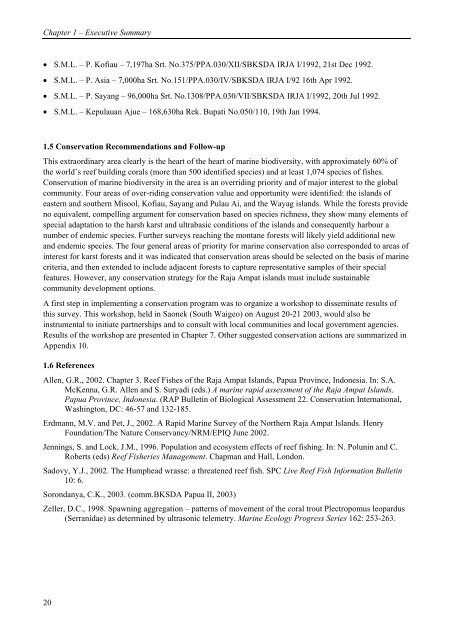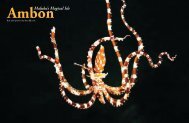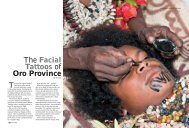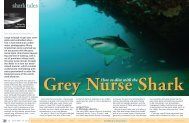Rapid Ecological Assessment - Indo-Pacific Images
Rapid Ecological Assessment - Indo-Pacific Images
Rapid Ecological Assessment - Indo-Pacific Images
- No tags were found...
Create successful ePaper yourself
Turn your PDF publications into a flip-book with our unique Google optimized e-Paper software.
Chapter 1 – Executive Summary<br />
• S.M.L. – P. Kofiau – 7,197ha Srt. No.375/PPA.030/XII/SBKSDA IRJA I/1992, 21st Dec 1992.<br />
• S.M.L. – P. Asia – 7,000ha Srt. No.151/PPA.030/IV/SBKSDA IRJA I/92 16th Apr 1992.<br />
• S.M.L. – P. Sayang – 96,000ha Srt. No.1308/PPA.030/VII/SBKSDA IRJA I/1992, 20th Jul 1992.<br />
• S.M.L. – Kepulauan Ajue – 168,630ha Rek. Bupati No.050/110, 19th Jan 1994.<br />
1.5 Conservation Recommendations and Follow-up<br />
This extraordinary area clearly is the heart of the heart of marine biodiversity, with approximately 60% of<br />
the world’s reef building corals (more than 500 identified species) and at least 1,074 species of fishes.<br />
Conservation of marine biodiversity in the area is an overriding priority and of major interest to the global<br />
community. Four areas of over-riding conservation value and opportunity were identified: the islands of<br />
eastern and southern Misool, Kofiau, Sayang and Pulau Ai, and the Wayag islands. While the forests provide<br />
no equivalent, compelling argument for conservation based on species richness, they show many elements of<br />
special adaptation to the harsh karst and ultrabasic conditions of the islands and consequently harbour a<br />
number of endemic species. Further surveys reaching the montane forests will likely yield additional new<br />
and endemic species. The four general areas of priority for marine conservation also corresponded to areas of<br />
interest for karst forests and it was indicated that conservation areas should be selected on the basis of marine<br />
criteria, and then extended to include adjacent forests to capture representative samples of their special<br />
features. However, any conservation strategy for the Raja Ampat islands must include sustainable<br />
community development options.<br />
A first step in implementing a conservation program was to organize a workshop to disseminate results of<br />
this survey. This workshop, held in Saonek (South Waigeo) on August 20-21 2003, would also be<br />
instrumental to initiate partnerships and to consult with local communities and local government agencies.<br />
Results of the workshop are presented in Chapter 7. Other suggested conservation actions are summarized in<br />
Appendix 10.<br />
1.6 References<br />
Allen, G.R., 2002. Chapter 3. Reef Fishes of the Raja Ampat Islands, Papua Province, <strong>Indo</strong>nesia. In: S.A.<br />
McKenna, G.R. Allen and S. Suryadi (eds.) A marine rapid assessment of the Raja Ampat Islands,<br />
Papua Province, <strong>Indo</strong>nesia. (RAP Bulletin of Biological <strong>Assessment</strong> 22. Conservation International,<br />
Washington, DC: 46-57 and 132-185.<br />
Erdmann, M.V. and Pet, J., 2002. A <strong>Rapid</strong> Marine Survey of the Northern Raja Ampat Islands. Henry<br />
Foundation/The Nature Conservancy/NRM/EPIQ June 2002.<br />
Jennings, S. and Lock, J.M., 1996. Population and ecosystem effects of reef fishing. In: N. Polunin and C.<br />
Roberts (eds) Reef Fisheries Management. Chapman and Hall, London.<br />
Sadovy, Y.J., 2002. The Humphead wrasse: a threatened reef fish. SPC Live Reef Fish Information Bulletin<br />
10: 6.<br />
Sorondanya, C.K., 2003. (comm.BKSDA Papua II, 2003)<br />
Zeller, D.C., 1998. Spawning aggregation – patterns of movement of the coral trout Plectropomus leopardus<br />
(Serranidae) as determined by ultrasonic telemetry. Marine Ecology Progress Series 162: 253-263.<br />
20





